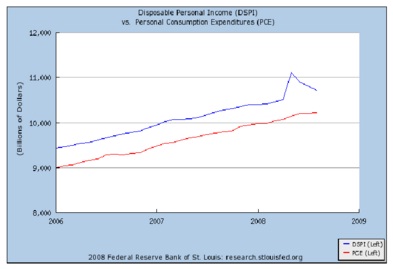1) The economy starts off in a recession. A fiscal stimulus through increased government spending is implemented, but it is not so large that it brings the economy all the way back to full employment (in other words, back to potential output level).
a. Initially, assume no monetary policy response to this scenario. Show the effects of this fiscal stimulus on the economy in the short run using both the IS-MP and Philips Curve diagrams. Explain briefly.
b. If central bankers decide they want to assist the economy in moving back towards full employment what should they do and why? Show this graphically as well.
c. Are there any other concerns the central bank should have when enacting their policy to bring the economy towards potential output levels? Explain briefly.
2) I saw a very interesting talk by notable economist John Taylor at a conference years ago. He showed us this graph showing the fiscal stimulus package of May 2008 (the spike in disposable income) :

a. The stated goal of the stimulus was to boost consumption. Did it work? Explain how you would arrive at the answer to this question using the graph.
b. Does the graph suggest that consumption depends on short run output levels (income) or potential output levels? Explain.
c. What economic theory is consistent with these results? Explain.
3. Use the IS -MP and PC graphs to analyze the following scenario on the economy. Specifically, how (and why) will real output (GDP) be affected in the short run.
The economy has recently recovered from a large recession. Job growth has been strong and consumption spending has risen enough to push the economy into a small boom. So, start this economy with current output above potential output and the real interest rate below the marginal product of capital. The central bank is concerned that this may cause the inflation to rise above their target. What will the central bank need to do to address this inflation concern? Show on the graph AND explain in words what will happen.